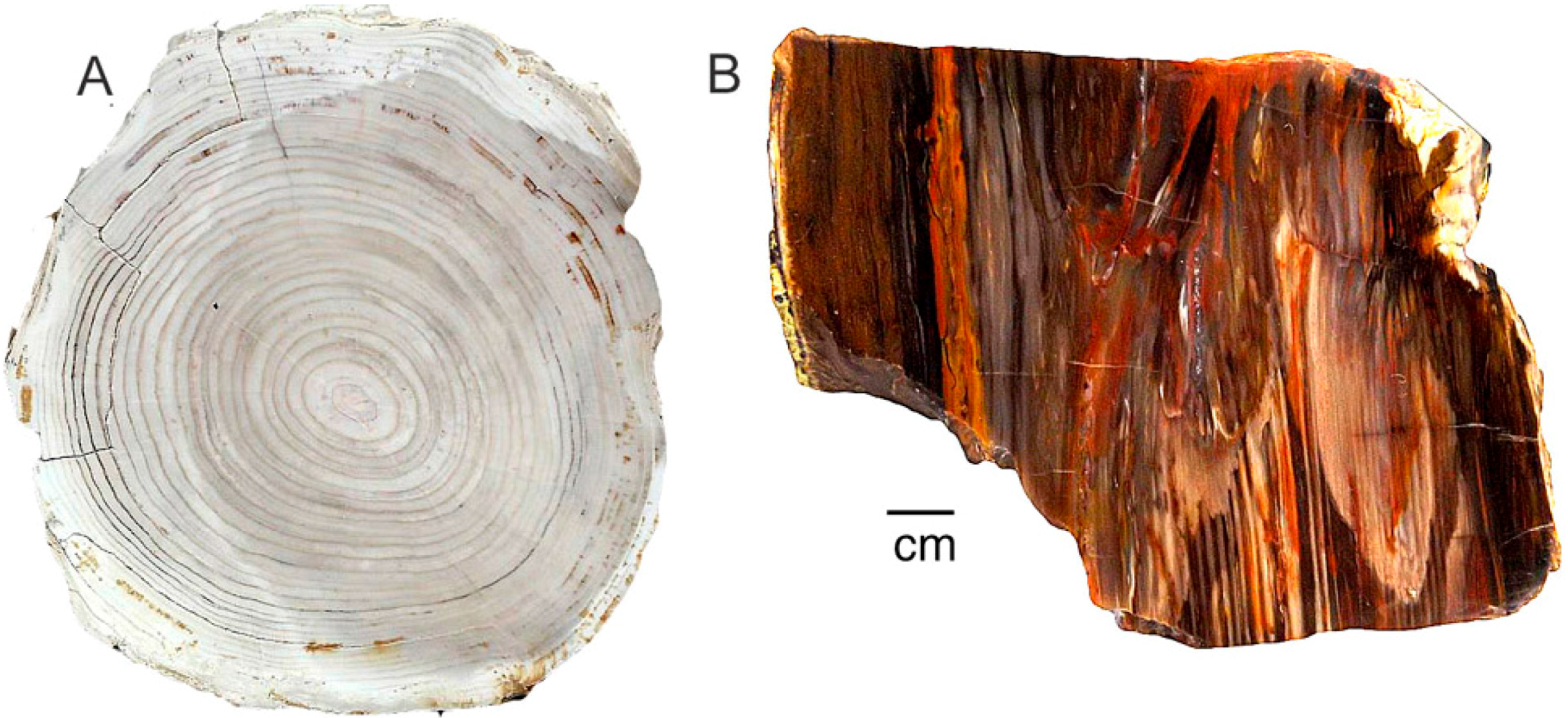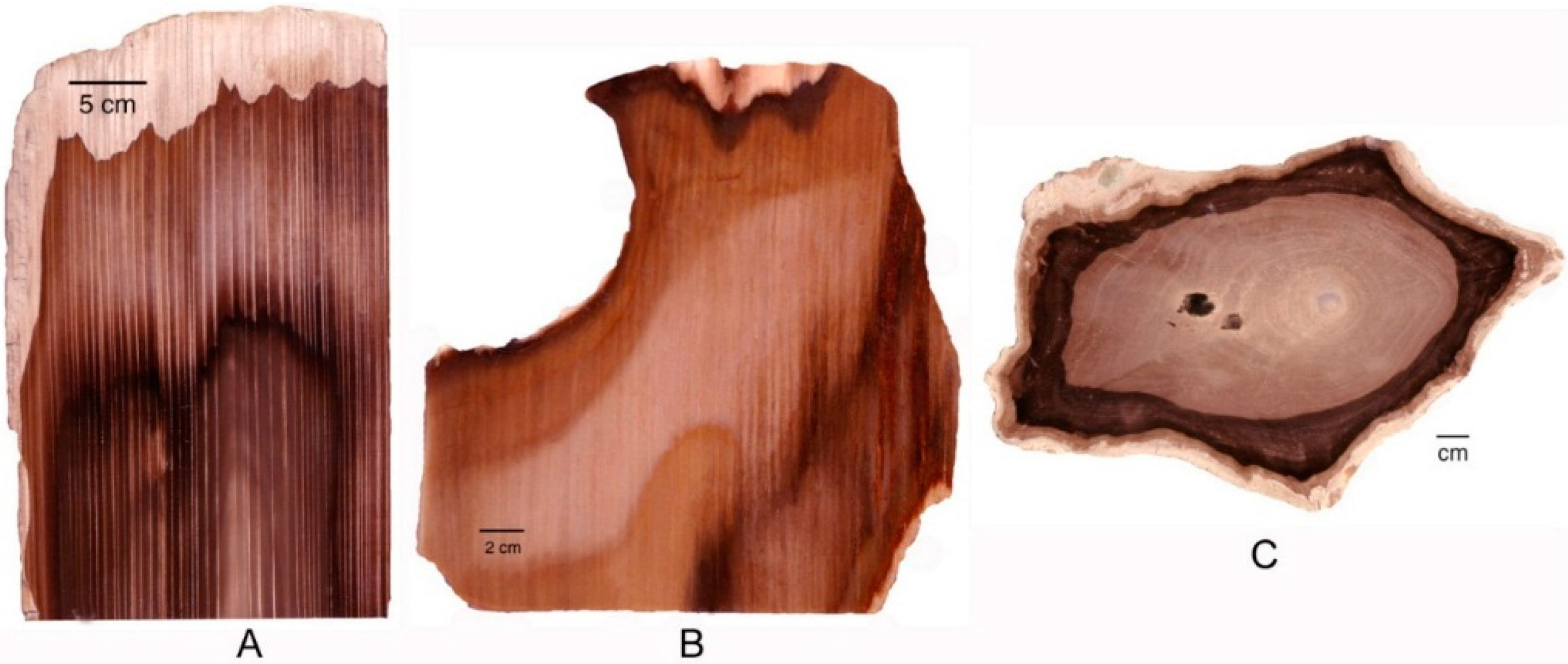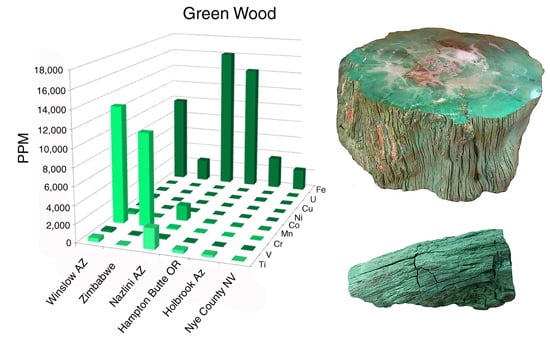Origin of Petrified Wood Color
Abstract
:1. Introduction
2. Metallic Elements as a Cause of Mineral Color
3. Previous Work
4. Methods
5. Results
5.1. Green Wood
5.2. Red Wood
5.3. Rainbow Colors
5.4. Black, White, Clear
5.5. Brown
6. Discussion
Iron Oxides
7. Geologic Source of Colorant Elements
8. Origin of Color Patterns
8.1. Groundwater Penetration along Natural Cellular Pathways
8.2. Multiple Episodes of Permineralization
8.3. Diffusion
8.4. Bleaching
8.5. Chromatography
8.6. Internal Voids and Open Fractures
8.7. Oxidation/Reduction
8.8. Relict Organic Matter
9. Conclusions
Acknowledgments
Author Contributions
Conflicts of Interest
Appendix
| Location | Age | Color | Pantone Color # | Ti | V | Cr | Mn | Fe | Co | Ni | Cu | U | |
|---|---|---|---|---|---|---|---|---|---|---|---|---|---|
| Green Wood | |||||||||||||
| Zimbabwe | Triassic | Light green | 7494C | 57 | 51 | 10,400 | 37 | 2465 | 12 | 28 | 34 | 1 | |
| Winslow AZ 1 | Triassic | Light green | 625C | 12 | 140 | 9600 | 38 | 293 | 9 | 8 | 7 | 3 | |
| Winslow AZ 2 | Triassic | Light green | 624C | 427 | 209 | 13,000 | 263 | 9900 | 80 | 176 | 69 | 2 | |
| Nye Co. NV | Miocene | Light green | 7494C | 41 | 41 | 6 | 33 | 2413 | 0.2 | 2 | 52 | 51 | |
| Holbrook AZ | Triassic | Dark green | 5545C | 244 | 24 | 10 | 46 | 3570 | 3 | 16 | 105 | 0.1 | |
| Nazlini AZ | Triassic | Dark green | 5535C | 2280 | 122 | 142 | 1690 | 16,100 | 49 | 30 | 102 | 9 | |
| Hampton Butte OR | Miocene | Dark green | 560c | 141 | 2 | 7 | 30 | 300 | 1 | 11 | 59 | 0.3 | |
| Hampton Butte OR | Miocene | Dark green | 555c | 326 | 46 | 31 | 87 | 14,280 | 5 | 21 | 33 | 0.2 | |
| Winslow AZ | Triassic | Dark green | 560C | 28 | 63 | 9030 | 16 | 974 | 10 | 39 | 29 | 2 | |
| Red Wood | |||||||||||||
| Holbrook AZ | Triassic | Red | 491C | 10 | 3 | 4 | 67 | 2030 | 0.1 | 7 | 15 | 8 | |
| Holbrook AZ | Triassc | Red | 483C | 37 | 5 | 1 | 47 | 1430 | 0.3 | 7 | 32 | - | |
| Nazlini AZ | Triassic | Red | 491C | 16 | 2 | 5 | 120 | 2520 | 0.3 | 8 | 11 | 15 | |
| Hampton Butte OR | Miocene | Red | 499C | 16 | 57 | 2 | 7 | 723 | 1 | 6 | 24 | 3 | |
| Texas Spring NV | Miocene | Red | 484C | 4 | 4 | 4 | 18 | 92 | 0.1 | 4 | 7 | 4 | |
| Madagascar | Jurassic | Brownish red | 484C | ||||||||||
| Rainbow Colors | |||||||||||||
| Nazlini AZ | Triassic | Orange | 131C | 9 | 1 | 1 | 40 | 1035 | 0.2 | 2 | 6 | 6 | |
| Nazlini AZ | Triassic | Yellow | 127C | 3 | 1 | 4 | 22 | 248 | 1 | 5 | 10 | 1 | |
| Holbrook AZ | Triassic | Yellow | 128C | 26 | 3 | 1 | 18 | 510 | 0.2 | 6 | 37 | - | |
| Holbrook AZ | Triassic | Light purple | 505C | 19 | 2 | 0.3 | 14 | 413 | 0.1 | 4 | 14 | - | |
| Holbrook AZ | Triassic | Dark purple | 5205C | 18 | 3 | 5 | 33 | 750 | 0.4 | 18 | 37 | - | |
| Nazlini AZ | Triassic | Orange | 1385C | 9 | 1 | 1 | 40 | 1035 | 0.2 | 2 | 6 | 6 | |
| Nazlini AZ | Triassic | Yellow | 1215C | 3 | 1 | 4 | 22 | 248 | 1 | 5 | 10 | 1 | |
| Nazlini AZ | Triassic | Pale pink | 217C | 2 | 1 | 3 | 9 | 495 | 0.0 | 4 | 5 | 0.0 | |
| White, Clear | |||||||||||||
| Nazlini AZ | Triassic | Clear | 1C | 8 | 1 | 1 | 3 | 35 | 0.1 | 3 | 5 | 8 | |
| Holbrook AZ | Triassic | Clear | 1C | ||||||||||
| Nye Co. NV | Miocene | Clear | 1C | 18 | 2 | 1 | 0 | 0 | 0 | 5 | 28 | - | |
| Holbrook AZ | Triassic | Clear | 1C | 8 | 1 | 1 | 3 | 35 | 0.1 | 3 | 5 | 0.0 | |
| Nye Co. NV | Miocene | White | 1C | 20 | 4 | 7 | 20 | 171 | 0.2 | 5 | 13 | 5 | |
| Texas Spring NV | Miocene | White | 7499C | 18 | 3 | 2 | 0 | 21 | 0 | 14 | 26 | - | |
| Holbrook Az | Triassic | Pinkish white | 5175C | 22 | 2 | 2 | 12 | 265 | 0.2 | 8 | 36 | 14 | |
| Brown, Black: | |||||||||||||
| Hampton Butte OR | Miocene | Medium brown | 463C | 2330 | 65 | 33 | 72 | 9046 | 5 | 23 | 36 | 1 | |
| Nye Co. NV | Miocene | Medium brown | 463C | ||||||||||
| Nye Co. NV | Miocene | Black | 447C | 28 | 8 | 3 | 9 | 250 | 0.3 | 5 | 16 | 3 | |
| Holbrook AZ | Triassic | Black stripe | 6C | 3 | 9 | 23 | 15 | 126 | 0.1 | 6 | 10 | 6 | |
| Nye Co. NV | Miocene | Gold | 19 | 2 | 3 | 0 | 342 | 0 | 9 | 13 | - | ||
| Texas Spring NV | Miocene | Dark brown | 7519C | 6 | 7 | 2 | 2 | 43 | 0.1 | 8 | 11 | 5 | |
| Nye Co NV | Miocene | Dark brown | 356 | 847 | 167 | 9 | 5870 | 6 | 8 | 24 | |||
| Goose Creek NV | Miocene | Medium Brown | 464C | 5 | 1 | 4 | 14 | 133 | 0.1 | 9 | 18 | 11 | |
| Goose Creek NV | Miocene | Tan | 466C | 23 | 2 | 8 | 23 | 225 | 0.4 | 22 | 48 | 1 | |
| Hampton Butte OR | Miocene | Golden brown | 463C | 16 | 57 | 2 | 7 | 723 | 1 | 6 | 24 | 3 | |
References
- Rossman, G.R. The colored varieties of the silica minerals. In Reviews in Mineralogy; Haney, P.J., Ed.; Mineralogical Society of America: Washington, DC, USA, 1994; pp. 433–468. [Google Scholar]
- Fritsch, E.; Rossman, G.R. An update on color in gems, part 1: Introduction and colors caused by dispersed metal ions. Gems Gemol. 1987, 23, 126–139. [Google Scholar] [CrossRef]
- Fritsch, E.; Rossman, G.R. An update on color in gems, part 2: Colors caused by charge transfers and color centers. Gems Gemol. 1988, 24, 3–15. [Google Scholar] [CrossRef]
- Fritsch, E.; Rossman, G.R. An update on color in gems, part 3: Colors caused by physical optics. Gems Gemol. 1988, 24, 81–103. [Google Scholar] [CrossRef]
- Fritsch, E.; Rossman, G.R. L’origine de la couleur dans les gemmes: 1ère partie. Rev. Gemmol. 1999, 137, 10–16. [Google Scholar]
- Fritsch, E.; Rossman, G.R. L’origine de la couleur dans les gemmes: 2ème partie. Rev. Gemmol. 1999, 138–139, 55–61. [Google Scholar]
- Loeffler, B.M.; Burns, R.G. Shedding light in the color of gems and minerals. Am. Sci. 1976, 54, 636–647. [Google Scholar]
- Rapp, G. Color of Minerals, ESCP Pamphlet Series PS-6; Houghton Mifflin Co.: Boston, MA, USA, 1971. [Google Scholar]
- Petrified wood color and petrification. Available online: http://scienceviews.com/parks/woodcolors.html (accessed on 5 May 2016).
- Petrified wood color. Available online: http://www.rockhounds.org/petrified-wood-colors/ (accessed on 5 May 2016).
- Sigleo, A.C. Geochemistry of silicified wood and associated sediments, Petrified Forest National Park, Arizona. Chem. Geol. 1979, 26, 151–163. [Google Scholar] [CrossRef]
- Daniels, F.J.; Dayvault, R.D. Ancient Forests. A Closer Look at Petrified Wood; Western Colorado Publishing Company: Grand Junction, CO, USA, 2006. [Google Scholar]
- Ash, S. Petrified Forest, a Story in Stone; Petrified Forest Museum Association: Petrified Forest, AZ, USA, 2005. [Google Scholar]
- Scott, A.C. Charcoal recognition, taphonomy, and uses in paleoenvironmental analysis. Palaeogeogr. Palaeoclimatol. Palaeecol. 2010, 291, 11–39. [Google Scholar] [CrossRef]
- Nassau, K. The origin of color in minerals. Am. Mineral. 1978, 63, 219–229. [Google Scholar]
- Cornell, R.M.; Schwertmann, U. The Iron Oxides: Structure, Reactions, Occurrences, and Uses; VCH Verlag GmbH & Co.: Weinheim, Germany, 1996. [Google Scholar]
- Barrón, V.; Torrent, J. Iron, manganese, and aluminum oxides and hydroxides. In EMU Notes in Mineralogy, vol. 14, Environmental Mineralogy II; Vaughan, D.J., Wogelius, R.A., Eds.; European Mineralogical Union: London, UK, 2013; pp. 297–336. [Google Scholar]
- Kerker, M.; Scheiner, P.; Cooke, D.D.; Kratohvil, J.P. Absorbance index and color of colloidal hematite. J. Colloid Interface Sci. 1979, 71, 176–187. [Google Scholar] [CrossRef]
- Hund, F. Inorganic pigments: Basis for colored, uncolored and transparent properties. Angew. Chem. Int. Ed. Eng. 1981, 20, 723–730. [Google Scholar] [CrossRef]
- Torrent, J.; Schwertmann, U.; Fechter, H.; Alferez, F. Quantitative relationship between soil color and hematite content. Soil Sci. 1983, 136, 354–358. [Google Scholar] [CrossRef]
- Ruby, C. Green rust and related iron containing compounds: Structure, redox properties and environmental applications: Part 1. Curr. Inorg. Chem. 2015, 5, 152–155. [Google Scholar] [CrossRef]
- Troulard, F.; Génin, J.M.R.; Abdelmoula, M.; Bourrié, G.; Humbert, B.; Herbillon, A. Identification of a green rust mineral in a reductomorphic soil by Mossbaur and Raman spectroscopies. Geochim. Cosmochim. Acta 1997, 61, 1107–1111. [Google Scholar] [CrossRef]
- Génin, J.-M.R.; Mills, S.J.; Christy, A.G.; Guérin, O.; Herbillon, A.J.; Kuzmann, E.; Ona-Nguema, G.; Ruby, C.; Upadhyay, C. Mössbauerite, Fe3+6O4(OH)8(CO3)·3H2O, the fully oxidized ‘green rust’ mineral from Mont Saint-Michel Bay, France. Mineral. Mag. 2014, 78, 447–465. [Google Scholar]
- Mills, S.J.; Christy, A.G.; Genin, J.-M.R.; Kameda, T.; Colombo, F. Nomenclature of the hydrotalcite supergroup: Natural layered double hydroxides. Mineral. Mag. 2012, 76, 1289–1336. [Google Scholar] [CrossRef]
- Young, H.E.; Gunn, V.P. Chemical elements in complete mature trees of seven species in Maine. TAPPI 1976, 49, 190–197. [Google Scholar]
- Mustoe, G.E. Late tertiary petrified wood from Nevada, USA: Evidence for multiple silicification pathways. Geosciences 2015, 5, 286–309. [Google Scholar] [CrossRef]
- Leo, R.F.; Barghoorn, E.S. Silicification of wood. Harv. Univ. Mus. Leafl. 1976, 25, 1–47. [Google Scholar]
- Mustoe, G.E. Density and loss on ignition as indicators of the fossilization of silicified wood. IAWA J. 2016, 37, 98–111. [Google Scholar] [CrossRef]





























| Mineral | Formula | Xl System | Color |
|---|---|---|---|
| Iron oxides: | |||
| Magnetite | Fe2+Fe3+2O4 | Isometric | Black |
| Wüstite | FeO | Isometric | Grayish white to yellow or brown |
| Hematite | α-Fe2O3 | Hexagonal | Earthy variety: dull red to bright red |
| Maghemite | γ-Fe2O3 | Isometric | brown |
| Akageneite | Fe3+O(OH,Cl) | Monoclinic | Yellow brown, reddish brown |
| Iron hydroxides: | |||
| Bernalite | Fe(OH)3 | Isometric | Green |
| Oxide/hydroxides: | |||
| Goethite | α-FeO(OH) | Orthorhombic | Yellowish to reddish to dark brown |
| Limonite | FeO(OH)·nH2O | Amorphous | Yellow to brown |
| Lepidocrocite | γ-FeO(OH)3 | Orthorhombic | Red to reddish brown |
| Feroxyhyte | ɗ-FeO(OH) | Hexagonal | Brown, yellowish brown |
| Ferrihydrite | (Fe3+)2O3·0.5H2O | Hexagonal | Dark brown, yellowish brown |
| Fougèrite | Fe42+Fe23+(OH)32(CO3)·3H2O | Hexagonal | Gray-green |
| Mӧssbauerite | Fe3+6O4(OH)8(CO3)·3H2O | Hexagonal | Blue-green |
| Trébeurdenite | Fe22+Fe43+(OH)10CO3·3H2O | Hexagonal | Gray-green |
| Schwertmannite | Fe8O8(OH)6(SO)·nH2O | Tetragonal | Orange |
© 2016 by the authors; licensee MDPI, Basel, Switzerland. This article is an open access article distributed under the terms and conditions of the Creative Commons Attribution (CC-BY) license (http://creativecommons.org/licenses/by/4.0/).
Share and Cite
Mustoe, G.; Acosta, M. Origin of Petrified Wood Color. Geosciences 2016, 6, 25. https://doi.org/10.3390/geosciences6020025
Mustoe G, Acosta M. Origin of Petrified Wood Color. Geosciences. 2016; 6(2):25. https://doi.org/10.3390/geosciences6020025
Chicago/Turabian StyleMustoe, George, and Marisa Acosta. 2016. "Origin of Petrified Wood Color" Geosciences 6, no. 2: 25. https://doi.org/10.3390/geosciences6020025








